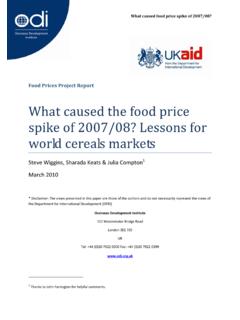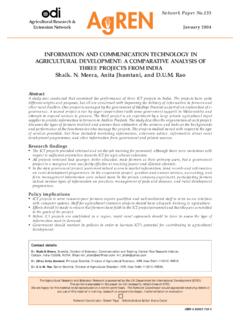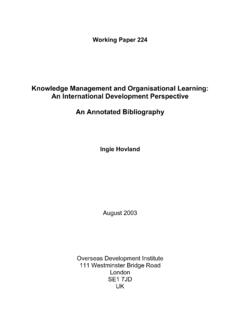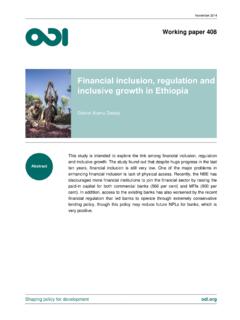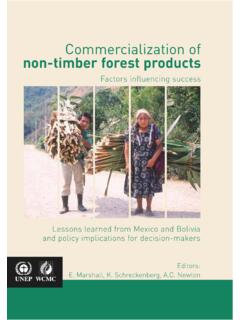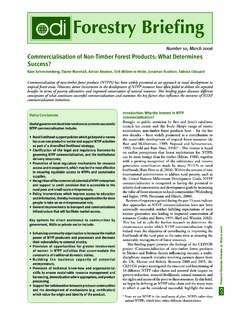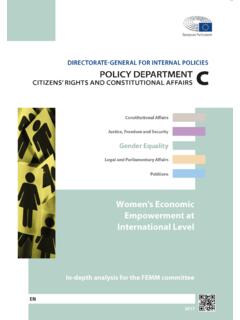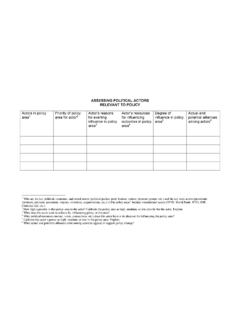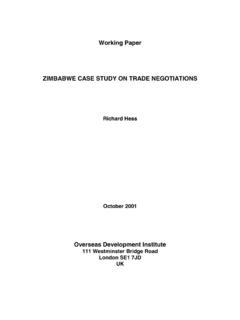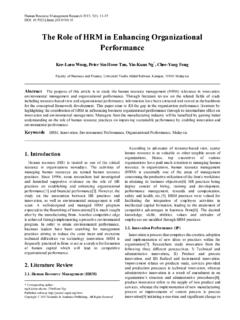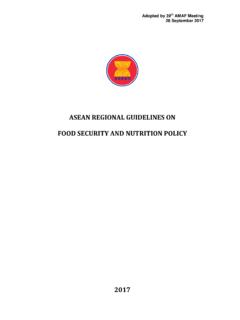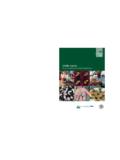Transcription of EMERGING ISSUES IN RURAL DEVELOPMENT
1 EMERGING ISSUESIN RURAL DEVELOPMENTAN ISSUES PAPERS imon Maxwell, Ian Urey and Caroline AshleyOverseas DEVELOPMENT InstituteLondonJanuary 20012 Introduction1. This paper lays out an 'argument' on RURAL DEVELOPMENT . The intention is to set thecurrent debate about RURAL DEVELOPMENT in context, and then examine EMERGING paper draws on the work of a team, whose background papers are The main elements of the argument can be summarised as follows:i. Most poverty in the world is RURAL , and reaching the International DevelopmentTargets means giving high priority to RURAL DEVELOPMENT ;ii. The nature of the problem is changing, however, and will change further -contemporary RURAL reality challenges our traditional view in a dozen differentways;iii.
2 There is no shortage of narratives about - or prescriptions on - ruraldevelopment. Past narratives have included Community DEVELOPMENT , 'theGreen Revolution' and 'Integrated RURAL DEVELOPMENT '. Current narrativesinclude 'a new, doubly-green revolution', 'sustainable agriculture', 'rurallivelihoods', and a growth-based, liberalisation-friendly narrative, which might belabelled the 'Washington consensus on agriculture and RURAL DEVELOPMENT ';iv. Embedded in these narratives are the critical choices about RURAL developmentpolicy: state or market; growth or stability; agriculture or non-agriculture; high orlow potential areas; expenditure on investment or consumption; etc.
3 V. Different narratives will apply in different places, but all need to be consistentwith current thinking on DEVELOPMENT more generally - which not all are, forexample on empowerment, the importance of income distribution, or the formand pace of market liberalisation;vi. Furthermore, the prescriptions currently on offer do not always capture thedegree and pace of change in RURAL areas, and new narratives are needed todeal with challenges such as globalisation, urbanisation, the 'de-agrarianisation'of RURAL space, the increasing diversity of RURAL environments, and the specialproblems of low potential areas - in particular, small-scale farming may be facingunprecedented and unmanageable pressures;vii.
4 In practice, there will not be one new RURAL DEVELOPMENT narrative, but all, however, the building blocks will need to include special attention to: thegrowing diversity of livelihood strategies; RURAL poverty in low potential areas; theimperative need for stronger social protection; conflict resolution andmanagement; the crisis of HIV/AIDS; and the need for greater decentralisationand devolution;viii. There are challenges here to RURAL DEVELOPMENT donors, which will need to bemet in the context of new aid modalities, for example Poverty Reduction StrategyPapers and Sector Wide Approaches the latter, at least, are problematic in thissector.
5 There will also be special problems in poorly performing countries. 1 The background papers and other materials are to be found in I. Urey (ed) ' EMERGING ISSUES in RuralDevelopment: A background paper , mimeo, Overseas DEVELOPMENT Institute, London, January 2001. Theprincipal contributors are: Caroline Ashley, Stephen Devereux, Andrew Dorward, Frank Ellis, John Farrington,Craig Johnson, Jonathan Kydd, Simon Maxwell, Daniel Start, Robert Tripp, Ian Urey, and Steve contributions were made by Alan Bojanic, Deborah Bryceson, Alex Duncan, Alison Evans, Saxena. The team would like to thank Felicity Proctor for her help and These notes tackle the argument in three steps: first, by setting RURAL poverty inchanging context; secondly, by reviewing the alternative approaches on offer; andthirdly, by dealing briefly with some EMERGING ISSUES .
6 The final section looks at theimplications for aid donors. References in brackets are to background poverty in context4. The extent of RURAL poverty and its weight in global poverty needs no great forthcoming IFAD RURAL Poverty Report 2001 claims that three quarters of the people living below $US 1 per day are RURAL ; and the Report estimates that by2020, 60 per cent of the world s poor will still be However, things aren t what they used to be , in four main ways: (a) small-scalefarming, peasant societies contain more marginal farming and landless families, andrural people earn their living in more diverse ways to the extent that some observersdescribe depeasantisation as the dominant RURAL phenomenon of our time.
7 (b) withinlimits, the geography and demographics of RURAL poverty are changing - more olderpeople, female-headed households, Africans, people living in low potential areas,people subject to conflict or exposed to HIV/AIDS, and so on; (c) the agricultural andrural economy is shrinking in relative importance, compared to the urban, industrial andservice economy; and (d) the RURAL economic environment is increasingly liberalised,integrated, even globalised. Table 1 summarises these changes. (Maxwell, Urey)6. Depeasantisation is uneven, and in many places the poor cling onto farming and ontosmall parcels of land.
8 Even here, however, livelihoods are more diverse, with at least45% of income derived from non-agricultural sources, and often 80%. Non-farm incomeis sometimes agriculture-dependent, but often not: long distance migration, usually tocities, sometimes international, contributes an increasing share of household income.(Bryceson)7. In the 1960s, agriculture accounted for perhaps 40 per cent of the national economy,and the RURAL economy as a whole for perhaps 60 per cent of the total. Agriculturalexports accounted for around 60 per cent of exports. By the end of the 1990s, thesefigures had generally halved at least, more in East Asia, less in sub-Saharan Africa.
9 (Maxwell)8. RURAL areas are more integrated into the world economy, as a result both ofliberalisation and improved infrastructure. World-wide, trade has grown twice as fast asGDP for several decades, and the rate seems to be increasing. RURAL producers,including small scale producers, are increasingly involved in global commodity chains.(Kydd and Dorward)9. The geography and demographics of RURAL poverty largely reflect the Africanisation and(arguably) feminisation of poverty more generally. A notable feature, however, is theconcentration of RURAL poverty in low potential areas perhaps two thirds of the ruralpoor live in areas of low agro-ecological potential and/or poor communications.
10 Conflictis also a regular feature of RURAL life in many areas: up to 20 % of Africans may beexposed to conflict in any year. (Farrington, Wiggins)4 Table 1: The changing context for RURAL developmentChanging ContextIllustrative dataDiversification is taking place in ruralincomesStudies for Africa show a range of 15 to 93 Percent reliance on non-farm income (WDR)More of the poor are in low potential areas66 Per cent of RURAL poor live in less favouredareas (IFPRI)There are growing environmental concerns An estimated loss of 2 billion hectares of landthrough degradation since 1945. (Conway)The geographical distribution of povertyand human (under) DEVELOPMENT ischanging23 per cent of Africans fail to reach the age of 40,compared to only 8 per cent of East Asians(UNDP)HIV/Aids is having a dramatic impact inSSALife expectancy has fallen by nine and six yearsrespectively in Botswana and Zambia.
